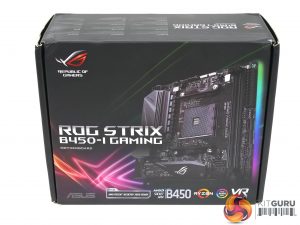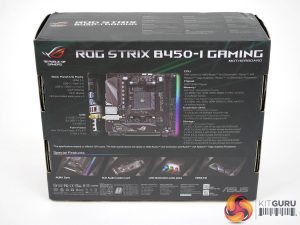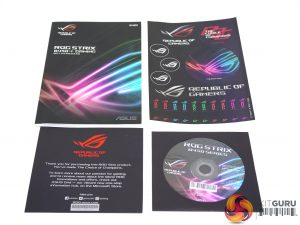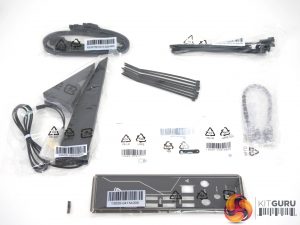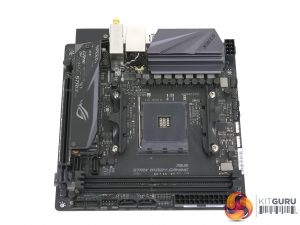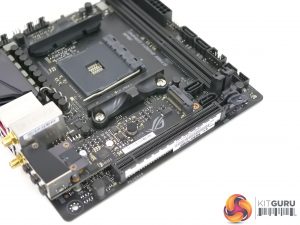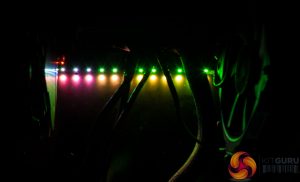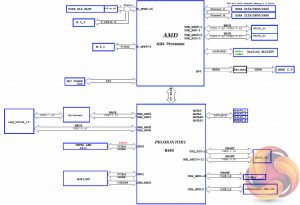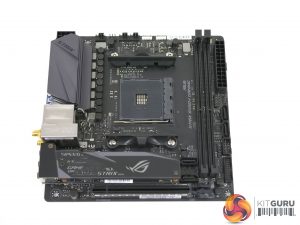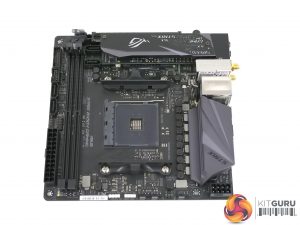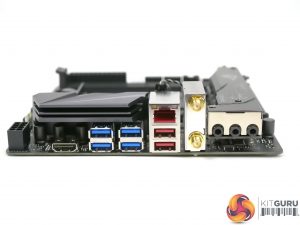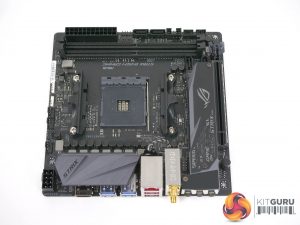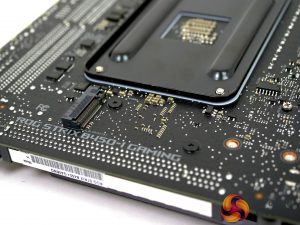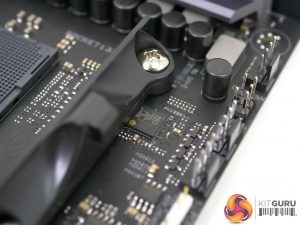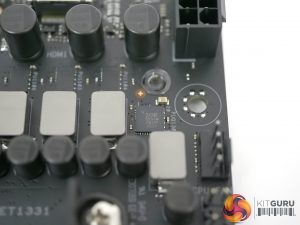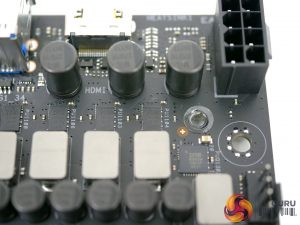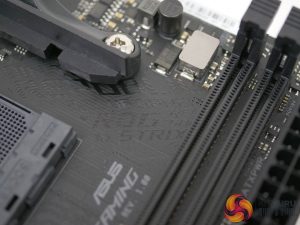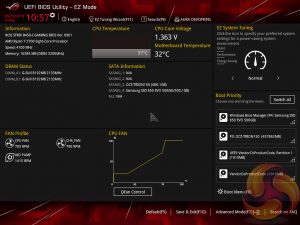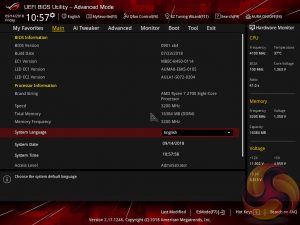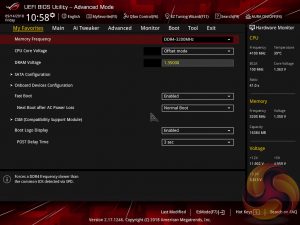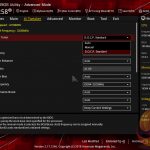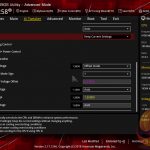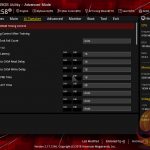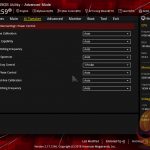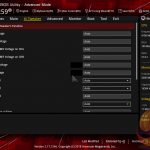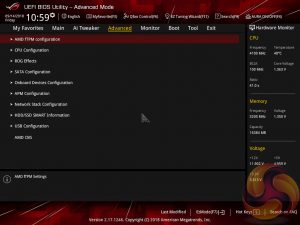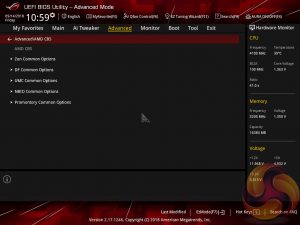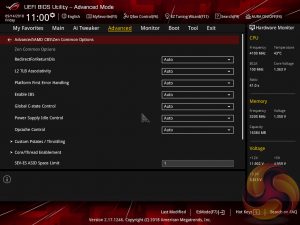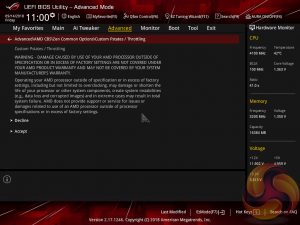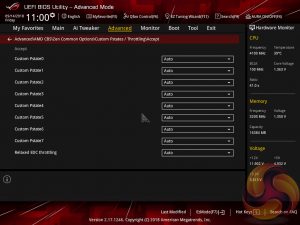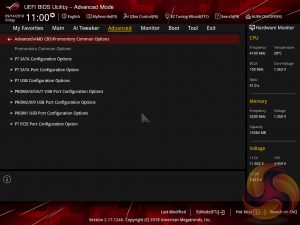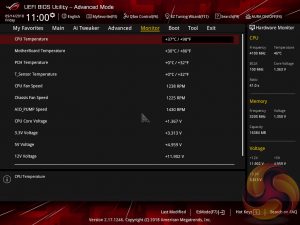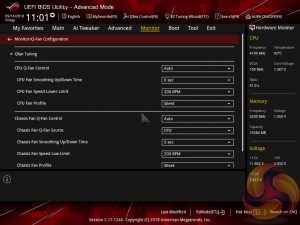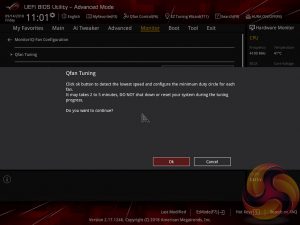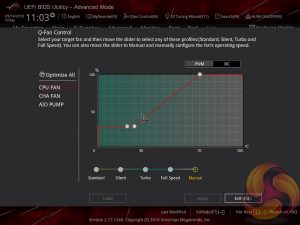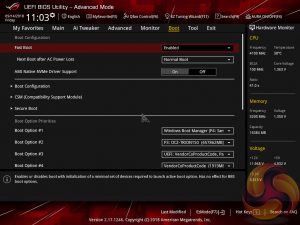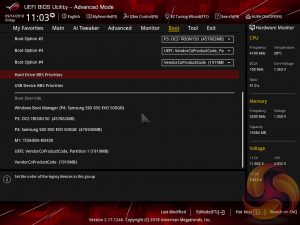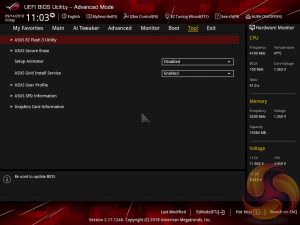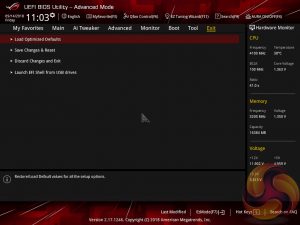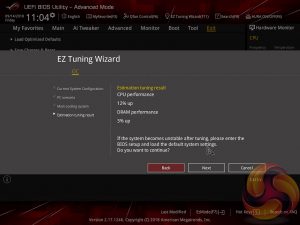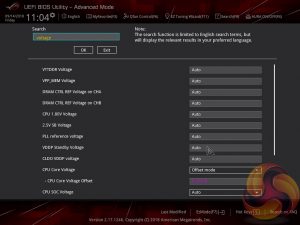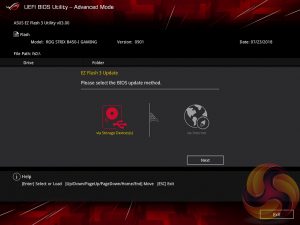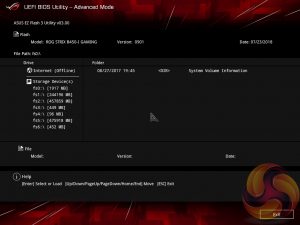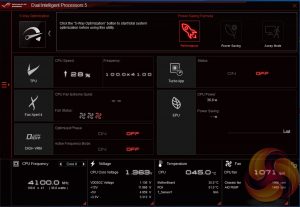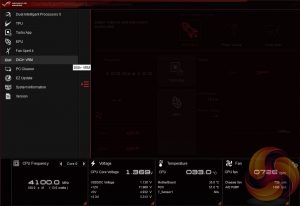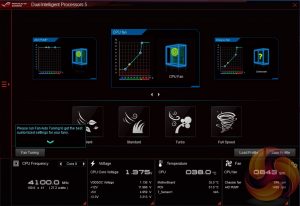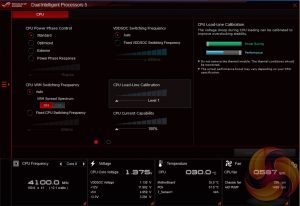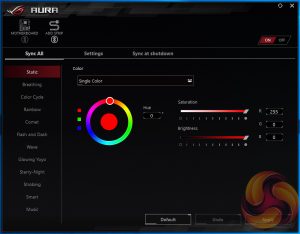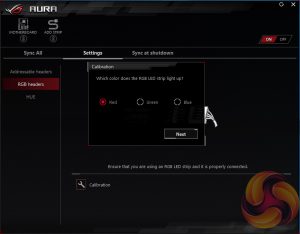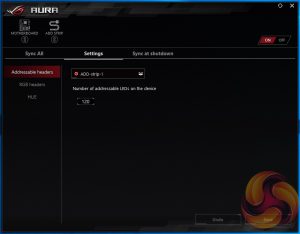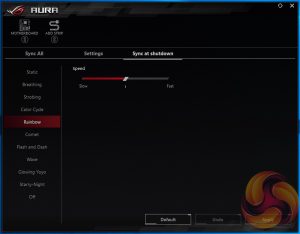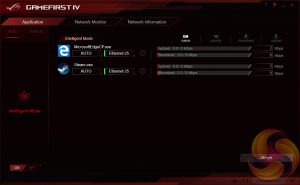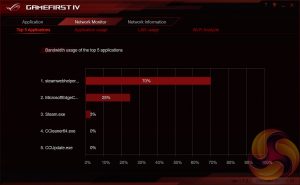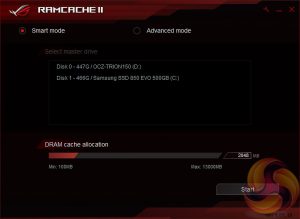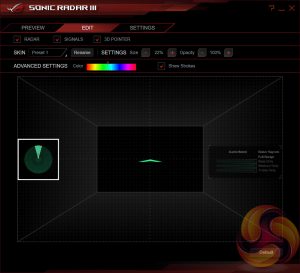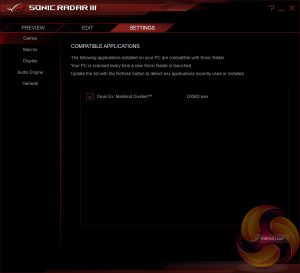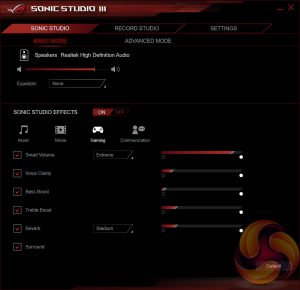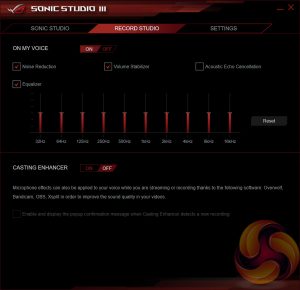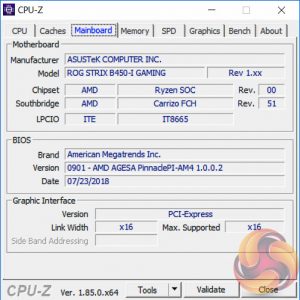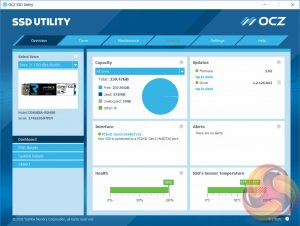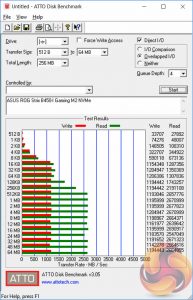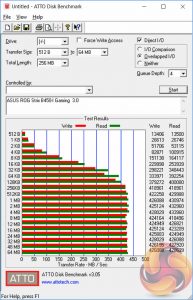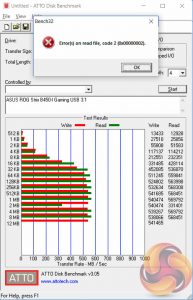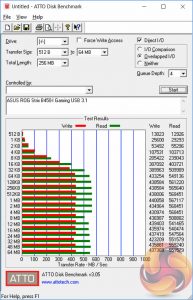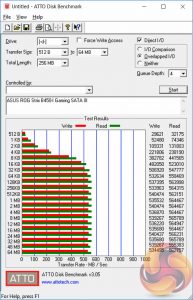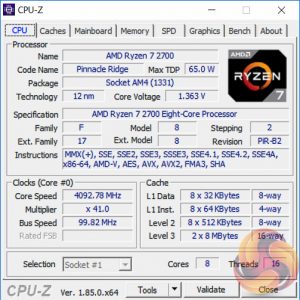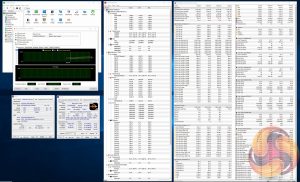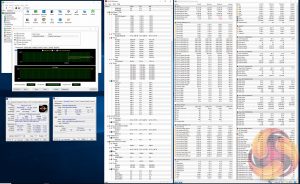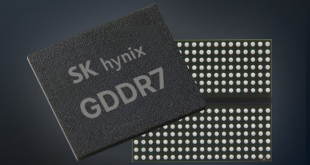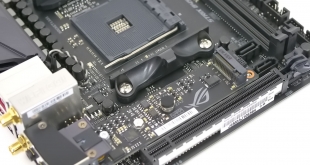
A compact mini-ITX system no longer has to be Intel by default as AMD's Ryzen CPUs have facilitated a plethora of appealing alternative options for the small form factor segment. In particular AMD's B450 chipset offers high-performance mini-ITX computing at a reasonable price point and sacrifices very little compared to the more costly AMD X470 chipset. As such motherboard vendors can build high-spec mini-ITX motherboards at competitive price points, the ASUS attempt of which is the ROG Strix B450-I Gaming.
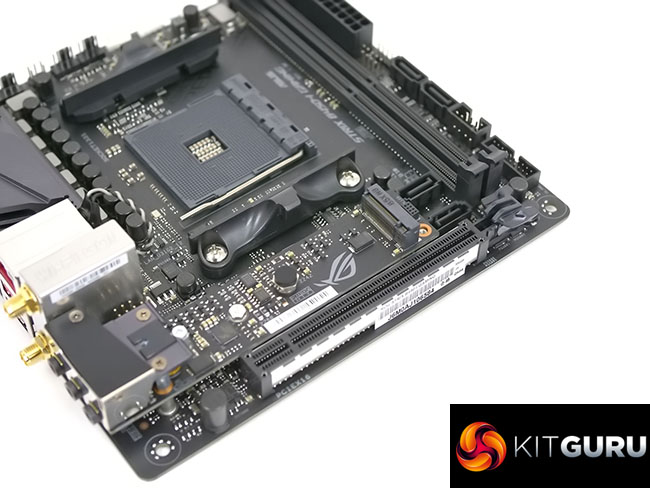
These days mini-ITX comes with minimal sacrifices and indeed the ASUS ROG Strix B450-I Gaming is in keeping with that idea. It features, take a breath, USB 3.1 10Gbps, dual M.2 ports, high quality Realtek ALC1220 based audio, a 6-phase CPU VRM, onboard WiFi and Gigabit LAN, onboard RGB LEDs and optional RGB headers.
In this instance ASUS has gone all out for AMD's 400-series chipsets with this and the very similar X470-I Gaming being the only mini-ITX motherboards on offer – there is no low-cost ASUS option and buyers looking for something cheaper may have to scour through previous generation 300-series stock.
It is perhaps a sensible approach to set the entry standard for Ryzen mini-ITX motherboards quite high to ensure that the high core count CPUs are backed with sufficiently capable VRMs. However, buyers looking for something on the cheaper end of the mini-ITX spectrum could well be drawn towards Intel motherboards based on H370, B360 and H310.
Clearly positioned towards gamers and power users, let's see how the ASUS ROG Strix B450-I Gaming fares in KitGuru's battery of analysis and tests.
| ASUS ROG Strix B450-I Gaming | |
| Form Factor | mini-ITX, 17cm x 17cm |
| CPU Socket | AMD AM4 |
| Chipset | AMD B450 |
| Memory | DDR4, 4 DIMMs up to 64GB, up to 3600MHz+ with OC |
| On-board Graphics | Radeon Vega Graphics (Supported APUs only) |
| Discrete Graphics | Single GPU Configurations only |
| Expansion Slots | 1 x PCIe 3.0 X16 |
| Storage | 4 x SATA 6Gbps (4 via B450) 2 x M.2 (M2_1 supports PCIe 3.0 x4 or SATA III, M2_2* supports PCIe 3.0 x4, up to 2280 form factor) *Unavailable when using Ryzen APUs, when populated the primary PCIe 3.0 X16 slot will operate at X8 |
| USB | 2 x USB 3.1 (2 Rear, via B450 chipset) 6 x USB 3.0 (4 Rear via AMD Ryzen CPU, 2 Front via B450 chipset) 2 x USB 2.0 (2 Front via B450 chipset) |
| Networking | Intel I211-AT Gigabit LAN Realtek 8822BE 2T2R 802.11ac Wireless LAN with Bluetooth v4.1 up 867Mbps |
| Audio | Realtek ALC1220 7.1 Channel HD Audio |
| RGB | 1 onboard RGB lighting zone (side strip near MB 24 pin) 1 x 12v G R B 1 x 5v Digital Header |
| Fan Headers | 3, all support 3/4 pin fans (1 x CPU, 1 x CHA, 1 x AIO_PUMP) |
| Rear I/O | 1 x HDMI 1 x LAN (RJ45) port(s) 2 x USB 3.1 Gen 2 (red)Type-A, 4 x USB 3.1 Gen 1 (blue) , 3 x LED-illuminated audio jacks 1 x ASUS Wi-Fi GO! module (Wi-Fi 802.11 a/b/g/n/ac and Bluetooth v4.1) |
| UEFI | 256Mb UEFI AMI |
The ASUS packaging is just as congested as the motherboard itself with the company frantic to highlight all the unique features of this mini-ITX powerhouse. Some of those highlighted features include the unique M.2 and audio combination card, LED-illuminated audio jacks and AURA Sync and USB 3.1 Gen 2.
The bundle includes various bits of documentation, a driver/utility DVD, cable labels, the I/O shield, SATA cables, cable ties, a WiFi antennae, an RGB LED extension cable and various mounting screws.
The aesthetic is typically plain given the limited space for styling flair on mini-ITX motherboards. There are two heatsinks, one which covers the CPU VRM and the other which covers the first M.2 slot, both feature the Strix and ROG branding. The overall colour scheme is a neutral black with some dark grey accenting.
As is to be expected for mini-ITX ASUS has implemented some creative engineering in order to fit everything in with a separate daughterboard that provides the audio, cooled M.2 slot and also doubles as the chipset heatsink.
Onboard RGB lighting is provided in a single zone underneath the 24-pin edge of the motherboard. As an aside the ROG Strix X470-I Gaming gets an additional onboard lighting zone on the separate daughterboard.
It's possible to expand on the default complement of RGB lighting with a 12v G R B strip and a 5v Digital strip, all of which are controlled using the provided ASUS AURA RGB software.
The block diagram provides a useful overview of how ASUS has provisioned available bandwidth from the CPU and B450 chipset. Interestingly, the second M.2 slot shares bandwidth with the only PCIe 3.0 slot on the motherboard, dropping that slot to X8 when the M.2 slot is in use.
The onboard connectivity is tightly packed in, four SATA ports cluster around the bottom corner along with one USB 2.0 and one USB 3.0 header.
The rear I/O provides a reasonable selection – six USB (4 USB 3.0 and 2 USB 3.1), one HDMI 2.0, the WiFi antennae ports and three LED-lit audio jacks. There is no USB 3.1 Type-C which may put some potential buyers off.
The onboard WiFi and Bluetooth is based on the Realtek 8822BE chip and provides 802.11ac WiFi up to 867Mbps with MU-MIMO support on 2 transmitters and 2 receivers, as well as Bluetooth v4.1.
Around the CPU socket is a trio of fan headers (CPU/AIO/CHA) and a pair of RGB Headers (12v, 5v).
The second M.2 slot, which shares its bandwidth with the primary x16 PCIe slot, is found underneath the motherboard, Due to the compact nature of the mini-ITX form factor up to 80mm drives are supported in both slots, no 110mm support.
The CPU PWM controller is the ASUS DIGI+ VRM package marked ASP1405I, widely understood to be the International Rectifier IR35201. On this motherboard it operates as 6+1 phases with six phases for the CPU and one phase for the SOC.
The six CPU phases are using IR3553M MOSFETs, which are capable of 40A, and the single SOC phase is using an IR3555M MOSFET capable of 60A.
Overall the CPU VRM is high quality and more than capable of handling the top Ryzen 7 CPUs. The primary concern seems to be the fact the SOC power, important for delivering power to APU integrated graphics, is only a single phase and features no heatsink cooling unlike the other six phases. Perhaps this motherboard is not the best choice for an APU build, particularly if the intention is to overclock the GPU component quite aggressively.
The ASUS UEFI enters straight into the EZ Mode splash screen which has a selection of frequently used settings including XMP profiles (called D.O.C.P on AMD ASUS motherboards), boot device order and fan speeds.
Pressing F7 takes the user into the advanced section of the UEFI but there are some additional tools that can be accessed from the splash screen such as Q-Fan Control and EZ System Tuning.
The first tab is MyFavorites which stores the most frequently accessed UEFI settings. The next tab, Main, contains detailed processor and BIOS version information.
If you are unable to display some of the images on these pages, disable your ad blocker as it interferes with our gallery code.
AI Tweaker is the UEFI tab which contains the vast majority of performance tuning settings pertaining to the CPU and DRAM. From here you can set XMP (D.O.C.P) profiles, overclock the CPU, set all the various voltages and voltage operation modes, change the Load Line Calibration (LLC) and considerably more.
LLC has 5 levels on this motherboard, with 1 being the least aggressive and 5 the most. The CPU voltage modes include override, adaptive and offset.
By enabling the automatic overclocking function (EZ Tuning Wizard) the CPU multiplier is simply set to 35 while the memory was ignored, when using the Ryzen 7 2700. Much better performance can be had through manual tuning and by enabling D.O.C.P (XMP).
Unlike on Intel platforms (such as Z370), enabling D.O.C.P/XMP does not set the CPU’s Turbo clock higher since the CPU Turbo behaviour is controlled by AMD’s proprietary XFR2 (Extended Frequency Range 2) and PB2 (Precision Boost 2) technologies.
There is a significant selection of performance and compatibility parameters to be found under the Advanced section should the need arise. As well as a number of other peculiar settings related to the functions of onboard devices, LEDs, USB and storage controllers and more.
On AM4 motherboards there is a section entitled AMD CBS which contains a large number of advanced settings specific to AMD’s AM4 platform. These include various power and thermal controls (C and P-States) and other platform-specific functions for the system chipset and CPU.
The Monitor tab will allow you to instruct the UEFI how to handle temperature data from the various sensors as well as what to do with fan speed profiles. For example, where a fan speed profile is temperature dependant you can choose which temperature sensor to use.
Q-Fan Control is a must-use utility since it will calculate the fan speed ranges of all PWM or DC fans on the 3 controllable fan headers. Once the voltage-to-fan-speed values have been calculated the user can then assign a preferred profile to each fan from the four presets (standard, silent, turbo, full speed) or simply set a custom profile using manual mode.
The Boot tab is as expected in delivering the key boot options such as secure boot, boot priority, boot override and boot compatibility options.
Users needing to update the UEFI (via the EZ Flash Utility), save, import or export BIOS settings, or secure erase a storage drive should refer to the Tool tab.
The Exit tab is fairly self-explanatory and helpfully provides a summary of changes upon exit.
The search function allows a text string to be searched against all the UEFI parameters. It isn’t a smart search so doesn’t have an auto-fill function and will not find similar items to your search string i.e. M.2 when M2 is searched.
We have tried the automated ASUS overclocking utility, EZ Tuning Wizard, before and it provides your CPU and memory with a crude automatic overclock depending on which options you select and the hardware you are using. In our case it provided 3.5GHz for the Ryzen 7 2700 and our memory was left unchanged at 2133MHz JEDEC when running from optimised defaults.
However, it applies a high “auto” voltage to account for variation in the quality of CPUs so it will often apply more voltage than necessary, it also fails to recognise XMP/D.O.C.P profiles and thus doesn’t get the most out of the memory. Users are better off setting the memory profile, attempting a manual overlock or leaving AMD’s XFR2 and PB2 to itself.
The EZ Flash utility is very simple to use and allows the UEFI to be updated from either a local disk or the internet using the Intel I211-AT Gigabit Ethernet adapter, but not over the onboard WiFi module.
The main software utility for the ASUS motherboard range is the multi-function AI Suite III (Dual Intelligent Processors 5). It contains within it a significant number of utilities including the EPU and TPU, the Turbo App for application-specific turbo behaviour, Fan Xpert 4, on-the-fly overclocking support, a cleaning utility and an ASUS software updating tool.
The ASUS AURA RGB software has gone through several iterations of redevelopment since KitGuru first assessed it and it is now a fairly slick application. The range of LED modes available to choose from is comprehensive but on this motherboard it doesn't seem possible, based on our testing, to manage LED strips independently of the onboard RGB lighting. There is a synchronise all option but this seems redundant given the aforementioned limitation.
The settings tab details a few more compatibility options such as for calibrating RGB LED strips, integrating a Hue Bridge (Phillips Hue product integration) and the Sync at shutdown tab allows users to specify the “turned off” (standby power after shutdown) behaviour of the motherboard’s RGB LEDs.
The ROG GameFirst IV software is now at version IV and is the ASUS packet prioritisation software of choice for the on-board Intel I211-AT Gigabit LAN and Realtek 8822BE WiFi. There are a variety of application profiles that can be set on a per-application basis, nominating one application as higher priority over another will allow it to use more of the total available bandwidth and have higher priority for send and receive requests.
This version of ROG GameFirst supports Multi-Gate teaming which allows the onboard WiFi to be used at the same time as the Wired LAN to combine all available network throughput.
The ROG RAMCache II software aims to help with program loading and file transfers of regularly accessed data. Users simply need to set aside the amount of RAM they would like for caching and the RAM Cache II software handles everything else behind the scenes when in Smart mode. There is an advanced mode that gives some additional parameters for user-control of the software’s behaviour if smart mode doesn’t suffice.
In a previous review KitGuru undertook brief testing of the software and saw a notable performance boost for the SATA-based operating system drive after it was cached.
ASUS Sonic Radar III is an application that translates positional audio signals into an “audio map” that identifies where specific noises originated from in supported games. Some PC anti-cheat platforms, such as PunkBuster and Steam VAC, are rumoured to prohibit the use of Sonic Radar III so any usage will need to be with caution.
However, ASUS claims Sonic Radar III is fair play with this explanatory statement: “Sonic Radar III uses in-game audio data to create a visual representation of the sound scape. This audio data exists as accessible game-play information for all players. Sonic Radar III simply presents this information in a way that is useful for training purposes, or as a benefit to gamers who may otherwise struggle to pick out vital positional-audio details — such as those with hearing difficulties.”
ASUS Sonic Studio III is an audio enhancement application which enables a range of different equaliser presets and HRTF-based (Head related transfer function) virtual surround for virtual reality headsets.
We will be outlining the ASUS ROG Strix B450-I Gaming motherboard's performance with the AMD Ryzen 7 2700 CPU, 16GB* of 3,200MHz G.Skill Trident Z DDR4 memory and a Gigabyte GTX 1080 G1 Gaming.
*16GB for mini-ITX motherboards, 32GB for all other motherboards.
B450/X470 Motherboard Test System:
- Processor: AMD Ryzen 7 2700 with Default AMD Turbo Behaviour (approx 3.35GHz when using all 8 cores)
- Memory: 32GB (4x8GB*) G.Skill Trident Z XMP/DOCP/AMP (3,200MHz** 16-18-18-38 @ 1.35V), *2x8GB for mini-ITX motherboards
- Graphics Card: Gigabyte GeForce GTX 1080 G1 Gaming.
- System Drive: Samsung 850 EVO 500GB SSD
- CPU Cooler: Corsair H100i V2 with Two ML120 Pro Fans.
- Power Supply: Seasonic Platinum 760W SS-760XP.
- Operating System: Windows 10 Pro 64-bit
Comparison X470 Motherboards:
- ASRock Fatal1ty X470 Gaming-ITX/ac
- ASUS ROG Strix B450-I Gaming
- ASUS ROG Strix X470-F Gaming
- MSI B450 Tomahawk
Drivers and UEFI:
- AMD Chipset 18.10.0601
- Nvidia GeForce 398.36 VGA drivers.
- ASUS UEFI Version 0901 (23/07/2018) with AMD AGESA PinnaclePI-AM4 1.0.0.2
Tests:
- Cinebench R15 – All-core CPU benchmark (CPU)
- SiSoft Sandra 2018 – Processor Arithmetic Test (CPU) and Memory Bandwidth Test (Memory)
- 7-Zip 18.05 x64 – Built-in 7-Zip benchmark test (CPU)
- AIDA64 Engineer 5.97 – System cache & memory benchmark and stress test (Memory and Power Consumption)
- 3DMark v2.5.5029 & TimeSpy v1.1 – Time Spy (1440p) test (Gaming)
- Ashes of the Singularity: Escalation – Built-in benchmark tool CPU-Focused test, 1920 x 1080, Extreme quality preset, DX12 mode (Gaming)
- Deus Ex: Mankind Divided – Built-in benchmark tool, 1920 x 1080, Ultra quality preset, DX12 mode (Gaming)
- ATTO 3.05 – M.2, USB 3.0, USB 3.1, and SATA 6Gbps transfer rates (Motherboard)
- Rightmark Audio Analyzer 6.4.4 – Record and playback test using a line-in to line-out loopback with a 3.5mm audio cable (Motherboard)
- HWiNFO 5.84/5.86 – System sensor monitoring during stress test (Power Consumption)
- Cybenetics Powenetics v2.2.0.0 – 12v EPS monitoring during stress test (Power Consumption)
7-Zip
7-Zip is an open source Windows utility for manipulating archives. We measure the Total Rating performance using the built-in benchmark tool. The test stresses all CPU cores to 100% and shows an affinity for memory bandwidth.
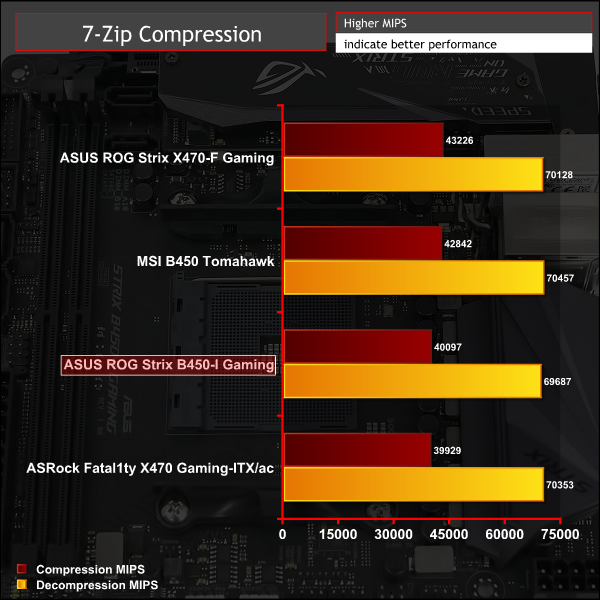
Cinebench R15
Cinebench is an application which renders a photorealistic 3D scene to benchmark a computer’s rendering performance, on one CPU core, all CPU cores or using the GPU. We run the test using the all core CPU mode.
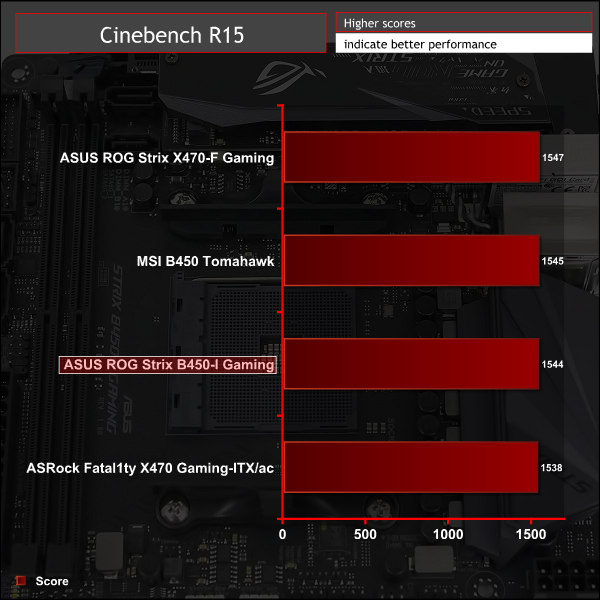
Sandra Processor Arithmetic
SiSoft Sandra 2018 is a multi-function utility program that supports remote analysis, benchmarking and diagnostic features for PCs, servers, mobile devices and networks. We run the application’s processor arithmetic test to gauge the CPU performance on each tested motherboard.
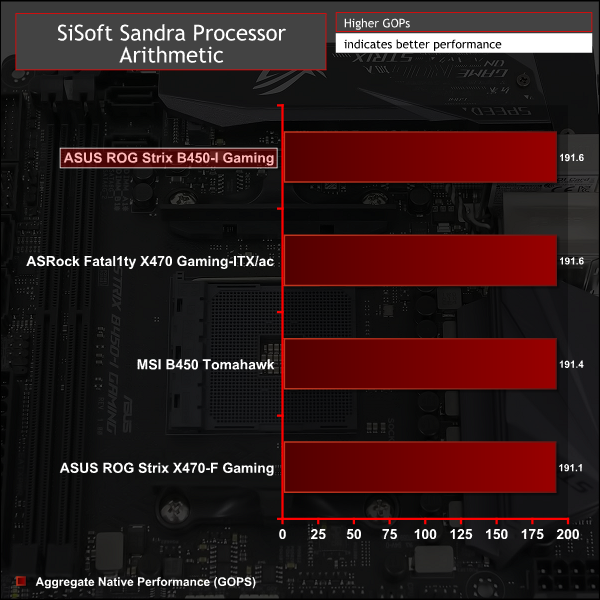
CPU performance is typical of the AMD Ryzen 7 2700 CPU and fairly consistent across all motherboards, which is what we'd expect given the role AMD's XFR2 and PB2 technologies play in ensuring CPU performance is always maximised within thermal and power constraints. There's no performance deficit for B450 compared to X470 chipsets.
For a rough guide of how CPU performance compares to Intel's Z370 platform, with an i7 8700K, please see KitGuru's most recent Z370 motherboard review. Please note software and driver versions have changed hence why we caution that results are not directly comparable.
AIDA64 Engineer
AIDA64 Engineer is a multi-featured software suite for diagnostics, stress testing, benchmarking, software auditing and various other measurement parameters. We use AIDA64 Engineer to benchmark memory throughput and latency.
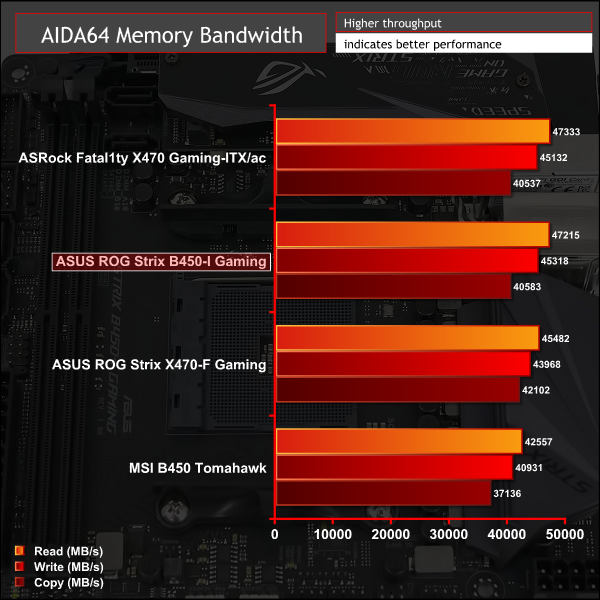
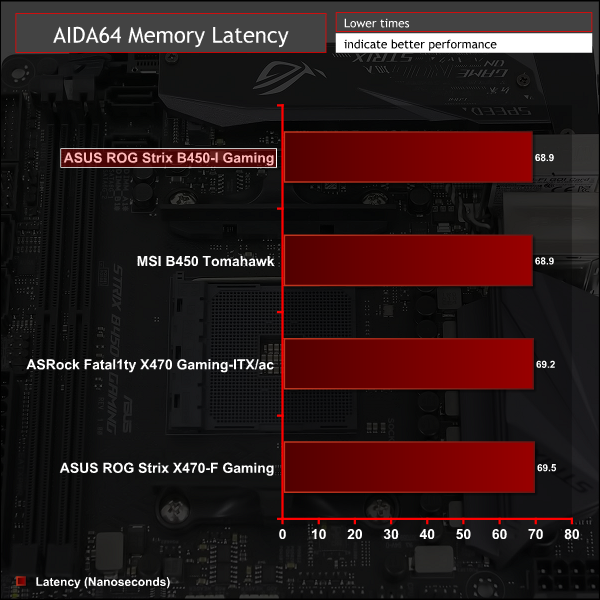
Sandra Memory Bandwidth
SiSoft Sandra 2018 is a multi-function utility program that supports remote analysis, benchmarking and diagnostic features for PCs, servers, mobile devices and networks. We use the SiSoft Sandra memory bandwidth test to provide a set of memory bandwidth results.
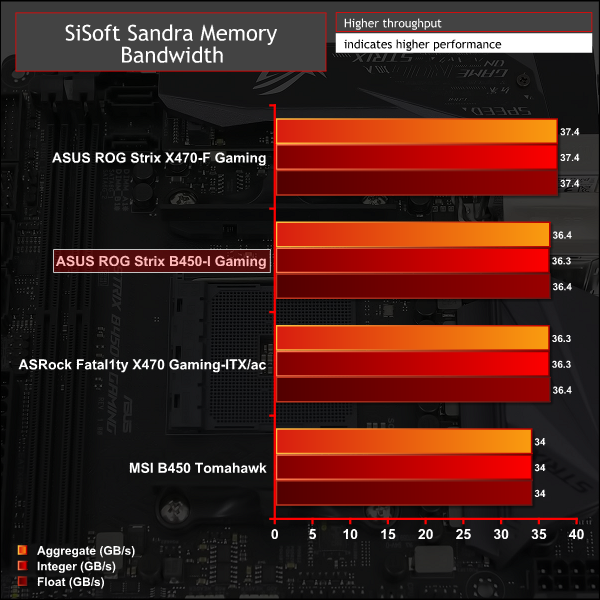
Memory performance for the ASUS B450 mini-ITX motherboard was very good and varied only slightly to the ASUS X470-F motherboard, likely because mini-ITX supports two less modules. Indeed, performance with the two-module ASRock X470 Gaming-ITX/ac was almost identical.
For a rough guide of how memory performance compares to Intel's Z370 platform, with an i7 8700K, please see KitGuru's most recent Z370 motherboard review. Please note software and driver versions have changed hence why we caution that results are not directly comparable.
3DMark
3DMark is a multi-platform hardware benchmark designed to test varying resolutions and detail levels of 3D gaming performance. We run the Windows platform test and in particular the Time Spy benchmark, which is indicative of high-end 1440p PC Gaming.
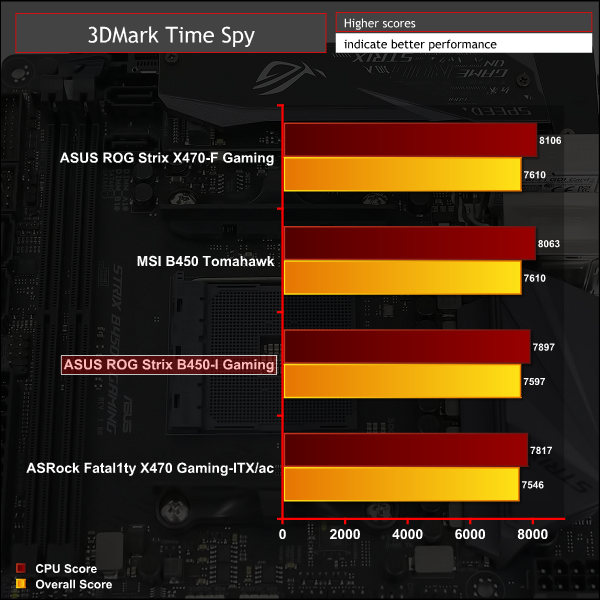
Ashes of the Singularity: Escalation
Ashes of the Singularity: Escalation is a Sci-Fi real-time strategy game built for the PC platform. The game includes a built-in benchmark tool and was one of the first available DirectX 12 benchmarks. We run the CPU-focused benchmark using DirectX 12, a 1080p resolution and the Extreme quality preset.
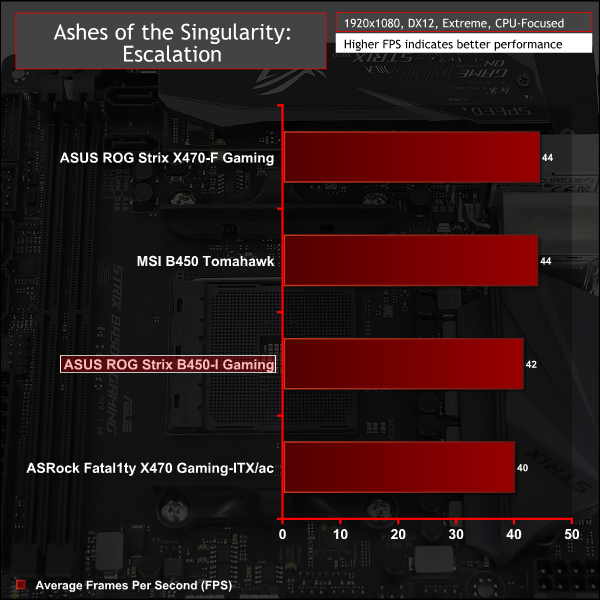
Deus Ex: Mankind Divided
Deus Ex: Mankind Divided is an action role-playing stealth video game released in August 2016. A built-in benchmark utility is included and we test using the Ultra quality preset and the DirectX 12 API at a 1080p resolution.
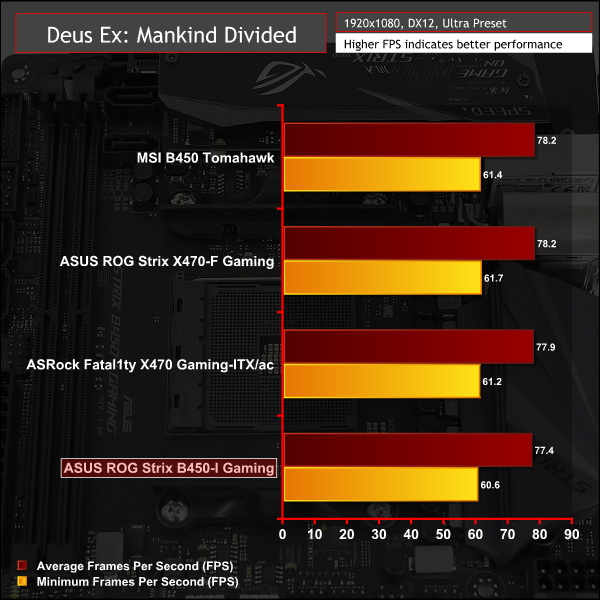
GPU performance was consistent with what we'd expect to see for this motherboard and CPU combination, it was also fairly similar to the ASRock X470 Gaming-ITX/ac.
For a rough guide of how gaming performance compares to Intel's Z370 platform, with an i7 8700K, please see KitGuru's most recent Z370 motherboard review. Please note software and driver versions have changed hence why we caution that results are not directly comparable.
ATTO Disk Benchmark
The ATTO disk benchmark is a Windows-based utility for testing storage performance of any storage drive or controller. We use the default benchmark setup.
M.2 PCIe Performance
For M.2 testing we use a Toshiba OCZ RD400 256GB M.2 PCIe NVMe SSD.
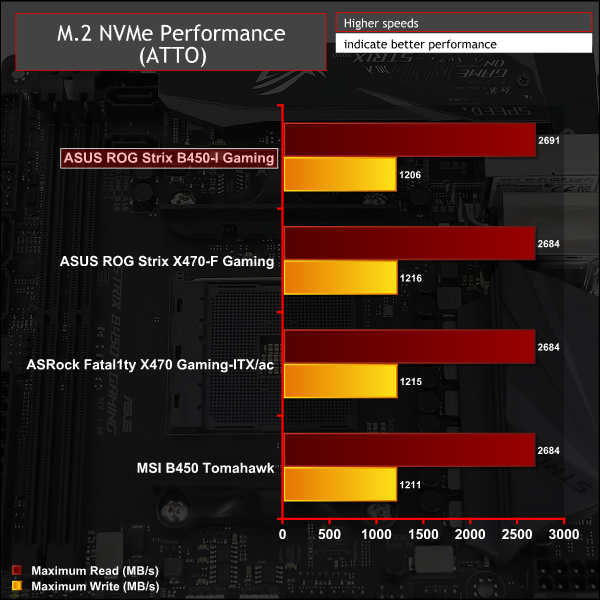
M.2 performance easily exploited the maximum performance potential of the benchmark drive. Thermal performance was very respectable too and the integrated M.2 heatsink performed well. Given the throttle speed is around 75-80 degrees Celsius most high performance drives should have no trouble performing consistently well with this motherboard.
USB Performance
We test USB 3.0 and 3.1 performance using a pair of Transcend SSD370S 512GB SSDs in RAID 0 connected to an RaidSonic Icy Box RD2253-U31 2-bay USB 3.1 enclosure powered by an ASMedia ASM1352R controller.
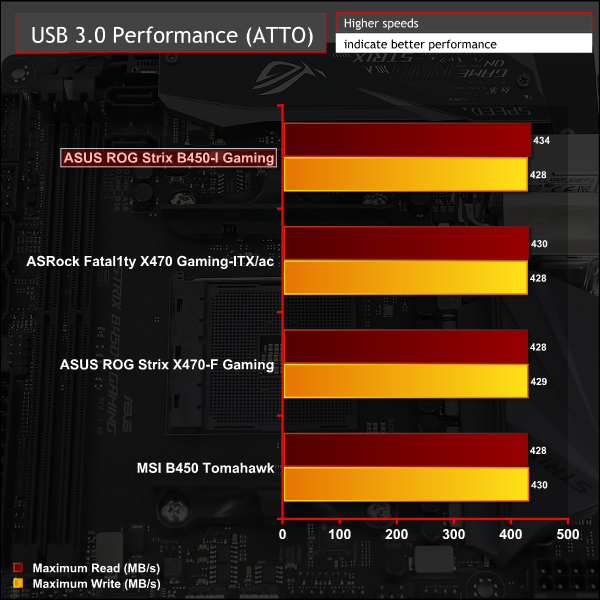
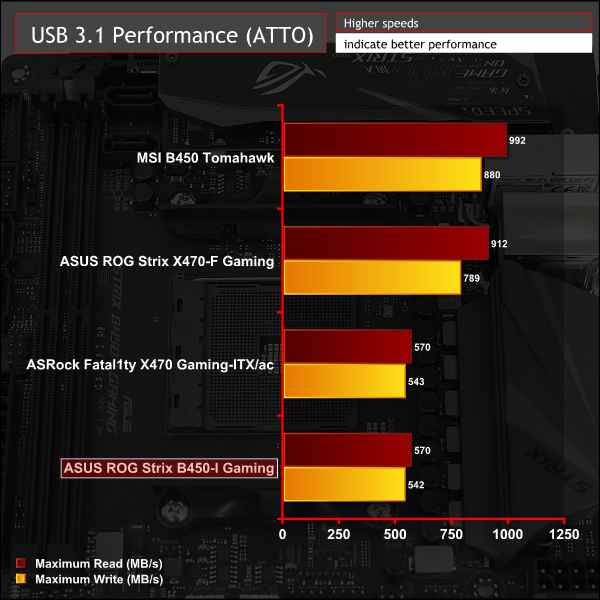
USB 3.0 performance was as expected while USB 3.1 performance experienced numerous performance and compatibility issues similar to those we observed with the ASRock X470 Gaming-ITX/ac motherboard.
Effectively, there's a bug where connected USB 3.1 devices disconnect during heavy and sustained loading. We experienced this bug using a USB 3.1 ASM1352R RAID box and ASM1351 USB 3.1 to SATA III device with the OCZ Trio 150 480GB SSD.
The only way we were able to complete an ATTO run from start to finish without interruption while using USB 3.1 was with the ASM1351 USB 3.1 to SATA III device and a Transcend SSD370S 512GB SSD.
Given the MSI B450 Tomahawk successfully completed USB 3.1 testing using the B450 chipset controller we can only assume this is a motherboard specific problem. It's difficult to say which USB 3.1 component causes the problem, as it is unlikely to be the controller.
We expect this ASUS motherboard and the ASRock X470 Gaming-ITX/ac must have a similarity somewhere as both failed in similar ways when using USB 3.1, our best educated guess at this stage is that it is potentially a compatibility issue with USB 3.1 redriver chip.
SATA III 6Gbps Performance
For SATA 6Gbps testing we use an OCZ Trion 150 480GB SSD.
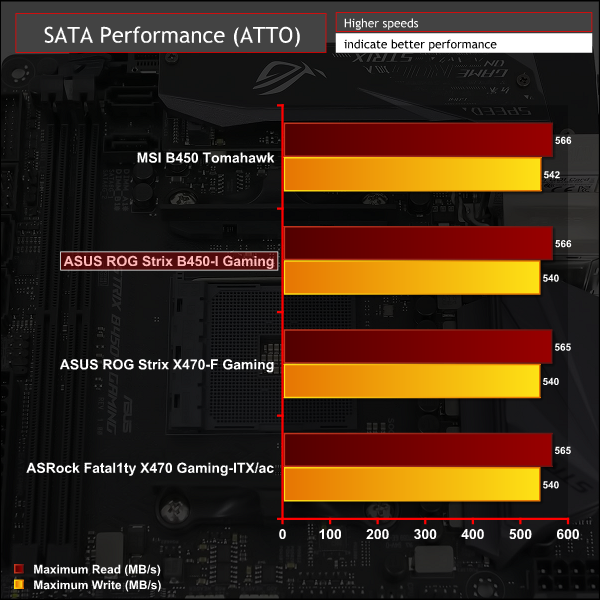
SATA performance was standard fare.
Audio
Rightmark Audio Analyser is a freeware benchmarking utility designed to objectively test the performance characteristics of audio solutions. We setup a line-in line-out loop and execute the record/playback test before generating the results report you see below. A sampling mode of 24-bit, 192 kHz is tested where available. If unavailable the closest alternative operating mode available is used and clearly marked.
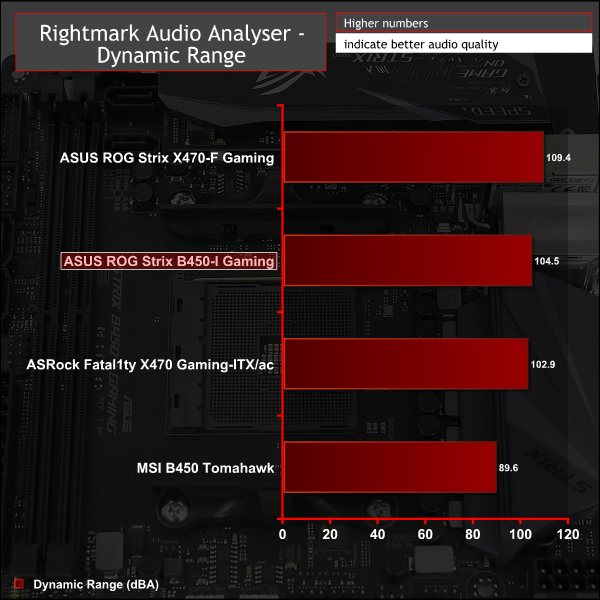
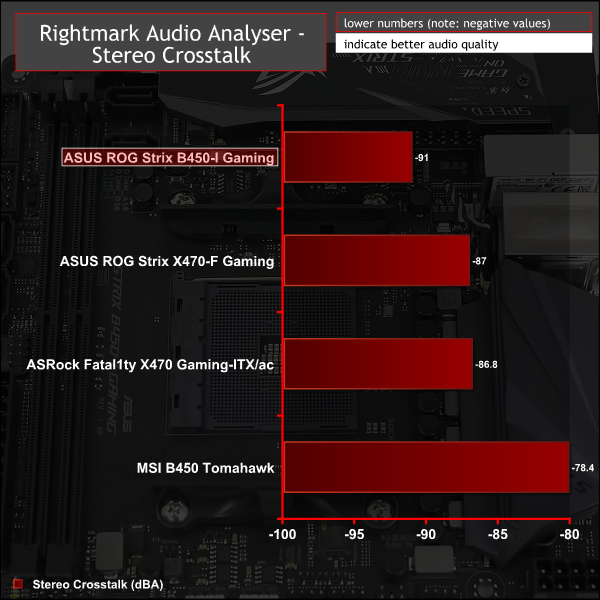
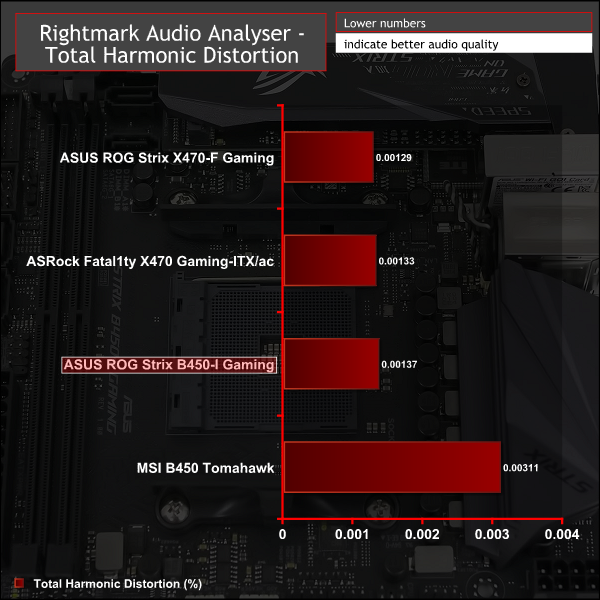

Audio performance was very good and the ASUS ROG Strix B450-I Gaming manages to keep pace with desktop motherboards using the same codec. This is likely due to the implementation of separate PCB for the audio which gave ASUS more space to implement high-end audio components like dual operational amplifiers and Nichicon audio capacitors.
Manual CPU Overclocking:
To test the ASUS ROG Strix B450-I Gaming motherboard’s CPU overclocking potential, we set the CPU core voltage no higher than 1.4V and push for the highest stable clock speed. We maintain the DRAM frequency at 3200MHz to take memory stability out of the overclocking equation. Once the highest clock speed for 1.4V is achieved we see if there is potential to reduce the voltage while maintaining system stability.
For overclocking we opted for 4.1GHz which is the highest all-core stable frequency our CPU sample is capable of. In terms of voltages we opted for a positive offset of 0.375v which resulted in about 1.36 volts. Initially we achieved 4.1GHz with 1.365v fixed voltage and noticed unusually high power consumption at idle. However, switching to the offset voltage mode didn't seem to reduce that power consumption at all despite having the “Ryzen Balanced” power plan selected in Windows 10.
Motherboard Sensors
There were no temperature sensors on the ASUS ROG Strix B450-I Gaming specifically labelled as “VRM” or “MOS”, but there were two sensors – “Motherboard” and “Temperature 3/4/5/6” – that could plausibly have been VRM sensors. These rose from 39/40 degrees Celsius at stock load to 41/48 at overclocked load.
Overclocked Performance
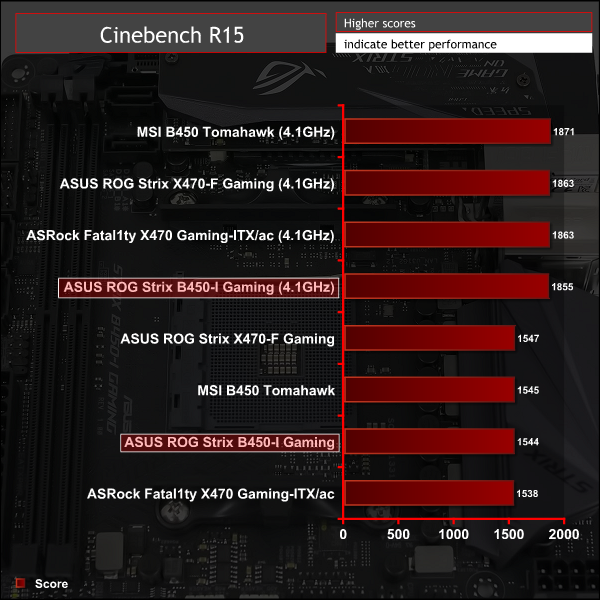
System Power Consumption
We leave the system to idle on the Windows 10 desktop for 10 minutes before taking a reading. For CPU load results we run AIDA64 CPU, FPU, Cache and Memory stress tests and take a reading after 10 minutes. The power consumption of our entire test system (at the wall) is shown in the chart.
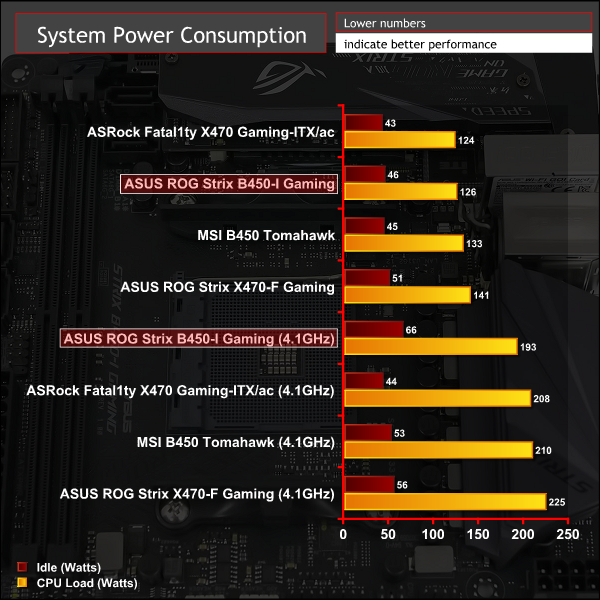
System power consumption was fairly typical under stock and load, if a little bit on the low side perhaps owing to the VRM's efficiency. However, overclocked idle power consumption was very high and we're not quite sure as to why. Even after using a voltage offset and the Ryzen Balanced or Power Saver Windows 10 power plans we were not able to get power consumption down despite the CPU having clocked down to idle speeds.
12-volt EPS Power Consumption
During the 10-minute stress test as specified above, we record the direct CPU power consumption drawn through the EPS 8-pin socket using modified EPS 8-pin cables that have a Tinkerforge Voltage/Current 1.0 bricklet intercepting and monitoring the power flow from the power supply. That bricklet then reports its data to a Tinkerforge Master Brick. All the data collected by the Tinkerforge Master Brick is passed into an external laptop over a USB connection and analysed in the Cybenetics Powenetics Project software.
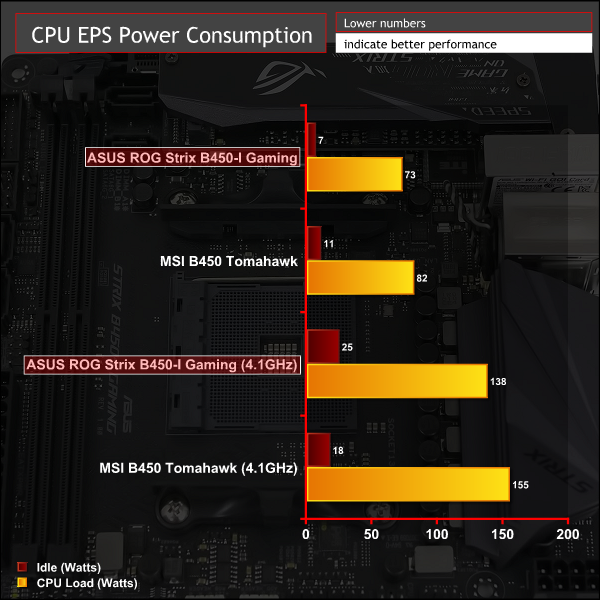
Stock CPU power consumption represents approximately 18% for idle and 65% for load of the system total, when adjusted for PSU efficiency*.
Overclocked CPU power consumption represents approximately 44% for idle and 78% for load of the system total, when adjusted for PSU efficiency*.
*Approximate Seasonic SS-760XP PSU efficiency at:
- 50-watts: 86%
- 125-watts: 89%
- 200-watts: 90%
The Powenetics software provides the power consumption at 12v input (pre-CPU VRM), and the Ryzen CPU provides the power consumption (CPU Package Power) after the CPU VRM has translated the power into a useful format (post-VRM). Based on this we can provide a rough estimate of VRM efficiency and “wasted” energy that likely translates into heat.
- Stock: 70-watts reported by CPU, 73-watts recorded, approximately 96% efficient and 3-watts of heat output.
- Overclocked: 128-watts reported, 138-watts recorded, approximately 93% efficient and 10-watts of heat output.
In the mini-ITX niche it is often the flagship motherboards that prove the most popular because the target market is more technically minded and DIY-inclined. ASUS knows this and has long tailored its mini-ITX offerings for an enthusiast-stroke-gamer audience.
The ASUS ROG Strix B450-I Gaming is an interesting proposition since ASUS is able to effectively deliver a near-identical motherboard to its flagship X470 equivalent, with a slightly reduced cost from the lesser chipset. There's an element of the best of both worlds in hitting a reasonable price point whilst still delivering a high-end feature-set.
That said this B450-I is by no means a low-cost solution, value-conscious buyers who are dead set on using AMD Ryzen CPUs could consider alternative cheaper options from rival motherboard vendors or even previous generation B350 mini-ITX motherboards where stocks remain.
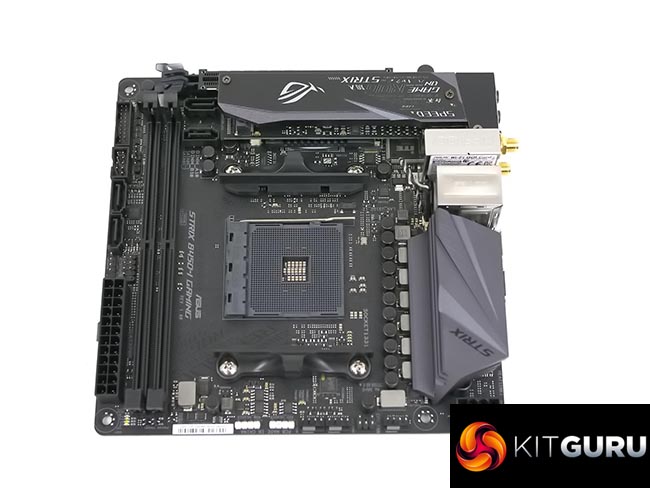
However, as a mini-ITX solution with minimal compromises it is hard to not be impressed by the ASUS ROG Strix B450-I Gaming. The ability for ASUS to cram in; dual M.2 slots, onboard WiFi, excellent RGB lighting options, a potent CPU power delivery system, M.2 cooling and high-end audio, is truly impressive.
There are only a few minor downsides to an otherwise excellent offering. Notably, the single SOC phase without heatsink cooling makes this motherboard a less than ideal choice for any APU builds. The quality of the single phase is good but the lack of cooling represents a concern, albeit only when using APUs. Additionally, we experienced compatibility and performance issues with the onboard USB 3.1 ports which were not possible to resolve. This isn't a major issue but anyone looking to take advantage of USB 3.1 bandwidth might struggle to do so depending on the device used.
On the whole the ASUS ROG Strix B450-I Gaming represents an excellent choice for AMD Ryzen small form factor builds and will make most consumers question the value of more expensive X470 alternatives.
The ASUS ROG Strix B450-I Gaming has a retail price of £158.99 in the UK and is usually sold with a 3 year warranty.
In the USA it can be had for $155 at Amazon and $155 at Newegg and usually has a 3 year warranty.
Pros:
- Dual M.2 with M.2 cooling
- High-spec audio
- Onboard WiFi, Bluetooth and Gigabit
- Onboard RGB lighting and RGB headers
- Good CPU VRMs
Cons:
- USB 3.1 compatibility problems
- Single phase SOC VRM with no heatsink – not ideal for APUs
- Less desirable Realtek Bluetooth and WiFi module used instead of Intel or Qualcomm
- High overclocked idle CPU power consumption
- LED strips not independently controllable of onboard RGB lighting
KitGuru says: The ASUS ROG Strix B450-I Gaming is a surprisingly affordable yet feature-rich mini-ITX motherboard with minimal compromises.
 KitGuru KitGuru.net – Tech News | Hardware News | Hardware Reviews | IOS | Mobile | Gaming | Graphics Cards
KitGuru KitGuru.net – Tech News | Hardware News | Hardware Reviews | IOS | Mobile | Gaming | Graphics Cards


